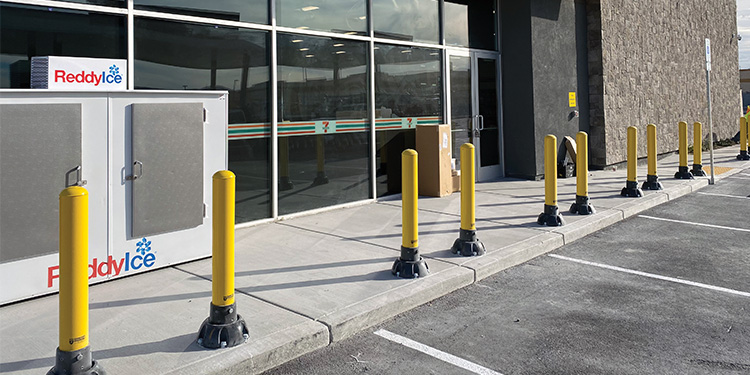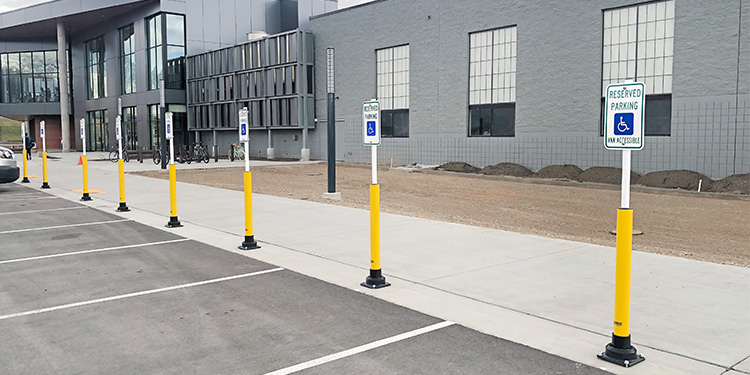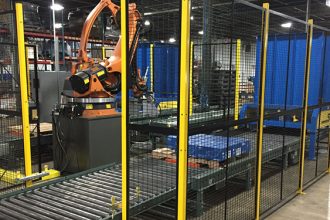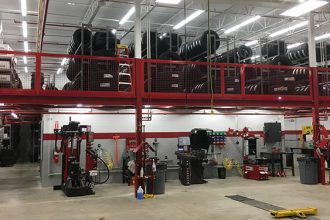5 Ways To Improve Warehouse Parking Lot Safety

Depending on how many shifts an operation runs, the parking lot of a warehouse, distribution center (DC), or fulfillment operation can be an extremely busy place. Not only are employees arriving in their personal vehicles and exiting them to walk into the facility, but also a variety of trucks, delivery vans, tractor trailers, and other vehicles may navigate through the same area. Fortunately, there are multiple ways to improve warehouse parking lot safety.
“Just as an operation utilizes protective guarding inside the four walls to keep structures and people safe from moving vehicles, the same should apply to outdoor areas,” explained Tim Lang, Business Solutions Manager for Impact Recovery Systems. The company is a member of the Protective Guarding Manufacturers Association (ProGMA).
In fact, many types of protective guarding solutions work both inside and outside, he said. “However, outdoor solutions may need to be more ruggedized or heavier duty due to weather exposure.”
Beyond Americans with Disabilities Act (ADA) requirements and state, local, or municipal codes for accessible parking spaces, no national standards exist for parking lot safety, Lang added.
“Best practice is to evaluate your facility’s parking lot for areas of potential risk. Then work with an experienced solutions provider — like the members of ProGMA — who can advise you on the products that can improve your parking lot safety. The goal is to deploy the solutions that minimize the chance of an accident in the parking lot.”
1. Directional and Instructional Signage
As their name implies, directional signs indicate which direction a vehicle should travel. Like street signs, these can feature arrows, verbiage, or both. Essentially, they tell drivers where to go. Instructional signage includes messaging and traffic warnings. These include stop signs, speed limits, handicapped parking spaces, no parking areas, and indicators of lot or facility entrances and exits.
“Directional signs are particularly helpful for people who’ve never navigated your parking lot before,” Lang said. “While employees are probably highly familiar with where the shipping and receiving docks are, drivers of delivery vehicles may not be. With signs, someone is less likely to drive into an area they shouldn’t.”
Lang advised that all signage used outdoors should include retroreflective sheeting to maximize parking lot safety. “This allows the signs to be clearly seen in the dark or in poor weather conditions, like rain or fog,” he said. “That makes the parking lot much easier to navigate.”
As for how many signs to use in a parking lot, no specific guidance exists. Lang recommended that common sense should prevail. “There is a balance between having enough signs for safety and having so many that some get overlooked,” he explained.
2. Pavement Markings
Like signage, pavement markings send a variety of messages. Painted stripes can indicate parking spaces, no parking zones, and pedestrian walkways. Directional arrows and speed limits can also be painted onto the parking lot’s surface.
“Be sure your striping vendor uses the right kind of product and at the appropriate thickness,” noted Lang. “Durability is important so the pavement markings can withstand different weather conditions and traffic patterns. You don’t want to be repainting your parking lot every six months. Adding glass beads to the product used for striping will create a retroreflective effect that makes the markings easier to see in the dark.”

3. Bollards and Guardrails
Whether they’re used inside and outside, bollards and guardrails serve a similar purpose. They provide a barrier that slows or stops a moving vehicle, protecting either people or a structure behind it.
Bollards are single posts anchored to the ground. Guardrails incorporate a series of anchored posts connected by horizontal rails. Depending on their construction and engineering, these barriers can absorb or deflect impact forces. They are often installed around the perimeter of a pedestrian walkway or in front of personnel entrances and exits. They can also protect structures, including building fixtures, dock doors, fire hydrants and more.
When choosing bollards and guardrails, consider the level of protection each offers and the potential impact scenarios these products may face, advised Lang.
“Make sure you purchase the right product for the application,” he said. “The worst thing that can happen is to have an accident that could have been prevented by purchasing the correct product.”
Painting bollards and guardrails safety yellow or white will enhance their visibility. However, some facilities opt to match a specific color scheme or corporate branding.
4. Traffic Delineators
Similar in appearance to a bollard, traffic delineators are lighter weight and lack the stopping power of their heavier duty counterparts. These vertical devices typically feature plastic construction and a flexible spring or other rebounding mechanism at the base. This allows them to tilt in the direction of the impact, then bounce back when the vehicle moves away.
These devices are usually a highly visible safety yellow, red, or white, making them easy to see. They enhance parking lot safety by clearly indicating traffic paths.
“Traffic delineators aren’t intended to stop a vehicle, but rather provide a visual indicator to segregate cars and trucks as they navigate through a parking lot,” Lang said. “They’re often used to separate entrance and exit lanes, or curves.”
5. Speed Bumps, Curbs, Wheel Guides, and Vehicle Stops
Other ways to enhance parking lot safety include adding features into the pavement itself. Speed bumps can prompt drivers to slow down to minimize jostling as they drive over them. Curbs can prevent vehicles from encroaching into areas they don’t belong — such as walkways.
Similarly, truck wheel guides mounted between dock doors act as curbs. These devices help tractor trailers or other delivery vehicles maintain proper alignment as they back into a dock opening. Further, to prevent a vehicle or trailer from rolling while parked, place portable vehicle stops (also known as wheel chocks) behind at least two of the wheels. They also minimize the risk of a premature departure.
Get More Guidance on Parking Lot Safety
For additional recommendations on ways to enhance an industrial facility’s parking lot safety, connect the members of the Protective Guarding Manufacturers Association (ProGMA). ProGMA promotes safety, security, and guarding for people, products, and facilities. The organization offers a variety of educational resources about protective barrier and guarding solutions, as well as develops and promotes industry standards.



